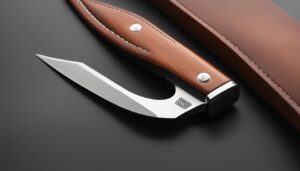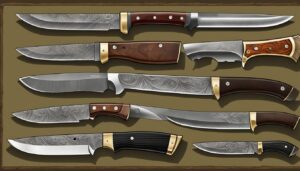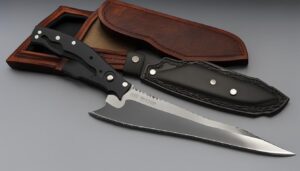The history of traditional hunting knife production is a fascinating tale that spans centuries. From the early days of the 19th century to the present, these knives have played a vital role in the lives of outdoor enthusiasts, hunters, and collectors. Join me on a journey through the evolution and legacy of traditional hunting knife production as we explore the rich history and cultural significance behind these iconic blades.
Key Takeaways:
- The history of traditional hunting knife production dates back to the 19th century.
- The Bowie knife, with its distinctive features, gained popularity and became a symbol of American frontier life.
- Bowie knives are characterized by their unique blade design and handle materials.
- Today, these knives are still widely used by outdoor enthusiasts, hunters, and collectors.
- Knife throwing, a skill with ancient origins, has evolved from survival technique to an art form and sport.
The Origins and Significance of the Bowie Knife
The Bowie knife, with its distinctive design and rich history, holds a significant place in the world of blades. It is credited to Jim Bowie, a renowned frontiersman and knife duelist of the 19th century. The origins of Bowie knives are deeply intertwined with Jim Bowie’s own story, adding to their historical significance.
“Jim Bowie’s reputation as a skilled fighter and his association with the Bowie knife contributed to its rise in popularity.”
The significance of Bowie knives lies not only in their connection to Jim Bowie but also in their versatile design and functionality. The large, fixed blades with clip points and false edges made them highly effective for hunting, self-defense, and combat purposes. Their practicality combined with Jim Bowie’s reputation as a skilled fighter and adventurer solidified their place in history.
“The Bowie knife served multiple purposes, ranging from hunting and self-defense to combat. Its practicality, combined with Jim Bowie’s reputation, contributed to its rise in popularity and legacy.”
The Bowie knife became a symbol of skill and craftsmanship, representing the spirit of the American frontier. Its legacy continues to inspire knife enthusiasts, collectors, and outdoor enthusiasts worldwide, making it an iconic piece in the world of blades.
The Significance of Bowie Knives in the 19th Century
During the 19th century, Bowie knives played a crucial role in the lives of early American pioneers and soldiers. They were not only tools for survival but also symbols of strength and independence. Whether used for hunting game, defending oneself against threats, or engaging in combat, Bowie knives were an essential part of daily life in the frontier.
- Practicality: The design of Bowie knives allowed for various functions, making them ideal for multiple tasks such as skinning game, chopping wood, and preparing food.
- Cultural Significance: Bowie knives became a symbol of the American frontier and the spirit of exploration and adventure. They represented self-reliance and rugged individualism.
- Legacy: The legacy of Bowie knives extends beyond their practical uses. Today, they are highly sought-after by collectors and knife enthusiasts who appreciate their historical significance and craftsmanship.
| Key Features | Significance |
|---|---|
| Large, fixed blade with a clip point and false edge | Enhanced versatility and effectiveness in hunting, self-defense, and combat. |
| Association with Jim Bowie | Added to the knife’s popularity and historical importance. |
| Symbol of the American frontier | Represented the spirit of exploration, independence, and self-reliance. |
| Legacy and collectibility | Valued by collectors and knife enthusiasts for their historical significance and craftsmanship. |
Defining Traits of Bowie Knives
The Bowie knife is renowned for its unique design and defining traits that set it apart from other blades. With its rich history and cultural significance, the Bowie knife stands as an iconic symbol of craftsmanship and functionality. Let’s explore the key characteristics that make Bowie knives truly exceptional.
Blade Design:
The blade of a Bowie knife is characterized by its length and curvature. Typically measuring between 6 to 12 inches in length and 1 to 2 inches in width, the blade is versatile and well-suited for various tasks. The legendary clip point adds precision to the blade, allowing for controlled cutting and piercing. The inclusion of a false edge increases the blade’s versatility, making it effective in combat situations.
Handle Design and Materials:
The handle of a Bowie knife is crafted with great attention to detail, providing a comfortable grip and enhancing the knife’s overall balance. Handles are often made from a variety of materials, including wood, bone, and synthetic materials. These materials not only offer durability but also add aesthetic appeal to the knife. The inclusion of a cross-guard ensures the user’s safety by preventing the hand from sliding onto the blade during use.
| Blade Design | Handle Design and Materials |
|---|---|
| – Length: 6 to 12 inches | – Wood |
| – Width: 1 to 2 inches | – Bone |
| – Clip point for precision | – Synthetic materials |
| – False edge for versatility | – Cross-guard for safety |
The defining traits of the Bowie knife contribute to its functionality and aesthetic appeal, making it a sought-after tool for outdoor enthusiasts, collectors, and knife enthusiasts alike. Whether used for hunting, camping, or display, the Bowie knife continues to captivate with its unique design and historical significance.
As we delve deeper into the history and evolution of traditional hunting knife production, it becomes clear that the Bowie knife holds a special place in the hearts of knife enthusiasts. Its iconic design, consisting of a versatile blade and a well-crafted handle, showcases the artistry and skill involved in its creation. The legacy of the Bowie knife lives on, cherished by those who appreciate its defining traits and the role it plays in the rich tapestry of knife-making history.
Contemporary Uses of Bowie Knives
Outdoor enthusiasts, hunters, campers, and collectors alike continue to find multiple applications for Bowie knives in various activities. The versatility and durability of these knives make them a valuable tool in the hands of those who appreciate their craftsmanship. Whether it’s for field dressing, skinning game, or general outdoor tasks, the Bowie knife remains a trusted companion.
For hunters, the Bowie knife is an indispensable tool when it comes to field dressing and skinning game. Its sharp and sturdy blade makes quick work of removing hides and preparing meat. The size and design of the Bowie knife allow for precise cuts and efficient processing, ensuring a successful hunt.
Campers and outdoor enthusiasts also find the Bowie knife to be a valuable asset during their adventures. From shelter construction to firewood chopping and food preparation, the Bowie knife’s strength and versatility shine through. Its ability to handle various tasks makes it a reliable tool in the wilderness.
Beyond its practical applications, the Bowie knife holds a special place in the hearts of collectors. Its historical significance, combined with the craftsmanship and artistry of the knives, make them highly sought after. Collectors appreciate the rich legacy and aesthetic appeal of these knives, turning them into valuable collector’s items.
Overall, the Bowie knife continues to be embraced by outdoor enthusiasts, hunters, campers, and collectors due to its practicality, durability, and historical significance. Whether in the hands of individuals venturing into the wild or those fascinated by its legacy, the Bowie knife remains an iconic symbol of craftsmanship and utility.
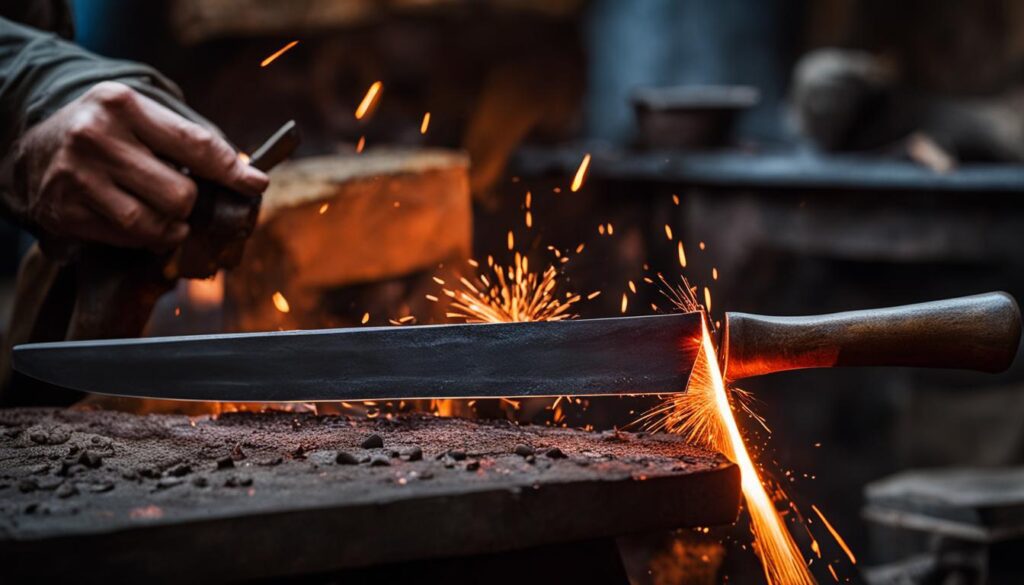
The Evolution of Bowie Knives
| Features | Traditional Bowie Knife | Contemporary Bowie Knife |
|---|---|---|
| Blade Length | 6 to 12 inches | 6 to 12 inches |
| Blade Design | Curved, clip point, false edge | Curved, clip point, false edge |
| Blade Material | High-grade steel | High-grade steel |
| Handle Material | Wood, bone, synthetics | Wood, bone, synthetics |
| Additional Features | Guard for safety | Guard for safety |
Despite the passage of time, the design and key features of the Bowie knife have remained largely unchanged. This is a testament to its functionality and effectiveness. Whether embracing its historical roots or appreciating its modern adaptations, the Bowie knife continues to be cherished by knife enthusiasts around the world.
Origins and Evolution of Knife Throwing
Knife throwing has a fascinating history that spans across various cultures and time periods. Its origins can be traced back to ancient civilizations such as Native American tribes, Japanese warriors, and African tribes. In Japan, knife throwing was developed as a combat skill for samurais, honing their accuracy and precision in battle. Meanwhile, tribes in different regions utilized knife throwing as a hunting technique, allowing them to silently take down prey from a distance.
As cultures interacted through trade and exploration, the techniques and practices of knife throwing merged and evolved. This led to the development of new styles and approaches that incorporated acrobatics and artistic elements. Over time, knife throwing transitioned from being solely a survival skill to an entertainment act, demonstrating impressive feats of precision and skill. Today, it is even recognized as a competitive sport in various parts of the world.
The Art of Knife Throwing in Martial Arts
Knife throwing also found its place in the realm of martial arts. It became an integral part of combat training for many warriors, enhancing their close-quarters combat skills and providing them with an advantage in battle. Knife throwing techniques were practiced alongside other forms of combat, such as hand-to-hand combat and weapon handling. The ability to accurately throw a knife at an opponent proved to be a valuable skill, allowing warriors to engage enemies from a safe distance.
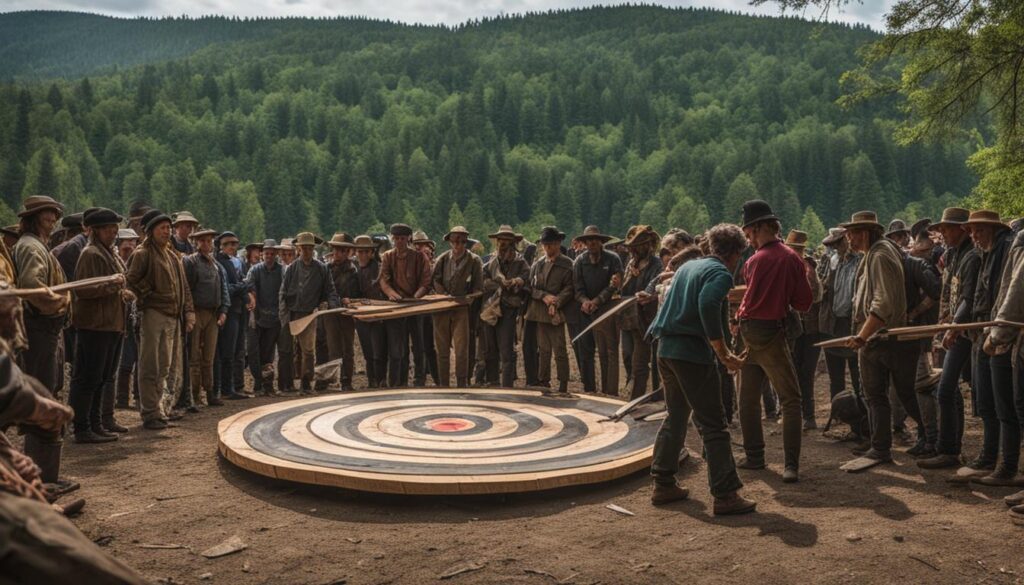

Furthermore, knife throwing became embedded in cultural practices and rituals. In some societies, it was performed during ceremonies to showcase bravery and skill. Others viewed knife throwing as a communal form of entertainment, bringing people together for shows and competitions. The artistry and precision involved in knife throwing transformed it into more than just a practical skill; it became an art form in its own right.
Knife Throwing in Hunting and Modern Applications
While the historical context of knife throwing often focused on combat and martial arts, it also had significant hunting applications. Hunters would employ knife throwing techniques to silently take down prey from a distance, minimizing the risk of startling or scaring off the animals. This allowed hunters to maintain a safe distance and increase their chances of a successful kill.
In contemporary times, knife throwing has become a popular recreational activity and sport. Enthusiasts participate in competitions, testing their skill and accuracy against others. Knife throwing clubs and organizations have also emerged, providing a community for like-minded individuals to share their passion and knowledge.
| Uses of Knife Throwing | Cultural Significance |
|---|---|
| Combat and martial arts training | Showcasing bravery and skill in ceremonies |
| Hunting and silent takedowns | Communal entertainment |
| Recreational activity and sport | Artistic expression |
Techniques and Cultural Significance of Knife Throwing
Knife throwing is an ancient art that has captivated cultures around the world for centuries. The techniques used in knife throwing have evolved over time, with practitioners developing various styles and approaches. Two primary techniques commonly employed in knife throwing are spin and no-spin techniques.
In spin techniques, the knife is thrown in a way that causes it to rotate during flight. This rotation helps to stabilize the knife and improve accuracy. It requires skillful coordination between the thrower’s hand and the knife’s rotation. Spin techniques are favored by many knife throwing enthusiasts and professionals who appreciate the challenge and precision involved.
In contrast, no-spin techniques rely on a linear motion with minimal rotation. The goal is to achieve a straight and controlled path for the knife, rather than relying on the spin for stability. No-spin techniques require a strong understanding of the knife’s weight and balance, as well as careful control of the throwing motion.
Historical Significance and Cultural Phenomena
Knife throwing holds historical significance in many cultures and has been practiced for diverse purposes. In some societies, knife throwing was originally developed as a combat skill, used by warriors and soldiers in battle. It demanded accuracy, stealth, and the ability to incapacitate adversaries from a distance.
Knife throwing also played a role in hunting applications, where it was used to immobilize prey or as a means of defense. In certain cultures, knife throwing became a ceremonial practice, often associated with rituals or rites of passage. It symbolized strength, dexterity, and connection to ancestral traditions.
Knife throwing has transcended its functional origins to become a form of entertainment and an art form. Its inclusion in circus acts, exhibitions, and competitions has contributed to its continued popularity worldwide.
The cultural significance of knife throwing varies across regions and time periods, with each society leaving its unique mark on the practice. Today, knife throwing continues to be embraced by individuals as a recreational activity, a competitive sport, and an art form that showcases skill, precision, and the rich heritage of knife throwing techniques.
Conclusion
The legacy of traditional hunting knife production, exemplified by the Bowie knife and knife throwing, holds immense historical significance and cultural value. These tools have evolved over time to serve practical purposes, while also becoming symbols of skill and craftsmanship. The journey of traditional hunting knife production is a captivating exploration of history, functionality, and cultural phenomena.
In contemporary times, traditional hunting knives and knife throwing continue to be appreciated by outdoor enthusiasts, collectors, martial artists, and knife enthusiasts worldwide. The legacy of these tools transcends generations, as they represent the spirit of adventure, self-reliance, and the pursuit of mastery. They serve as a reminder of our connection to the past and our innate human desire to explore and conquer the world around us.
Moreover, traditional hunting knife production has become embedded in cultural practices and traditions, adding an additional layer of significance. The craftsmanship and artistry involved in creating these knives have been passed down through generations, preserving the cultural heritage associated with their production. The traditional hunting knife, with its rich history and cultural roots, continues to be an object of admiration and appreciation.
Overall, the legacy of traditional hunting knife production and its historical significance make it a fascinating subject of study. These tools not only serve practical purposes but also represent a cultural phenomena that continues to captivate and inspire. The exploration of traditional hunting knife production is a journey that uncovers the stories of the past and allows us to appreciate the art, craftsmanship, and cultural value associated with these timeless tools.
FAQ
What is the history of traditional hunting knife production?
The history of traditional hunting knife production can be traced back to the 19th century when the Bowie knife gained popularity due to its connection with Jim Bowie, a legendary frontiersman.
Who is credited with the creation of the Bowie knife?
The Bowie knife is credited to Jim Bowie, a prominent frontiersman and knife duelist of the 19th century.
What are the defining traits of Bowie knives?
Bowie knives are characterized by a large, fixed blade with a clip point and a false edge. The blade is typically made of high-grade steel, while the handle is made of materials such as wood, bone, or synthetics.
What are the contemporary uses of Bowie knives?
Bowie knives are widely used by outdoor enthusiasts, hunters, campers, and collectors. They serve purposes such as hunting, field dressing, skinning game, shelter construction, firewood chopping, and food preparation.
What is the history of knife throwing?
Knife throwing has a rich history that dates back to ancient civilizations such as Native American tribes, Japanese warriors, and African tribes. It originated as a combat skill and hunting technique.
What are the techniques and cultural significance of knife throwing?
Knife throwing techniques have evolved over time, with spin and no-spin techniques being the primary approaches. Knife throwing has cultural significance across societies and has been used for combat, hunting, ceremonial rituals, communal entertainment, and as an art form.


